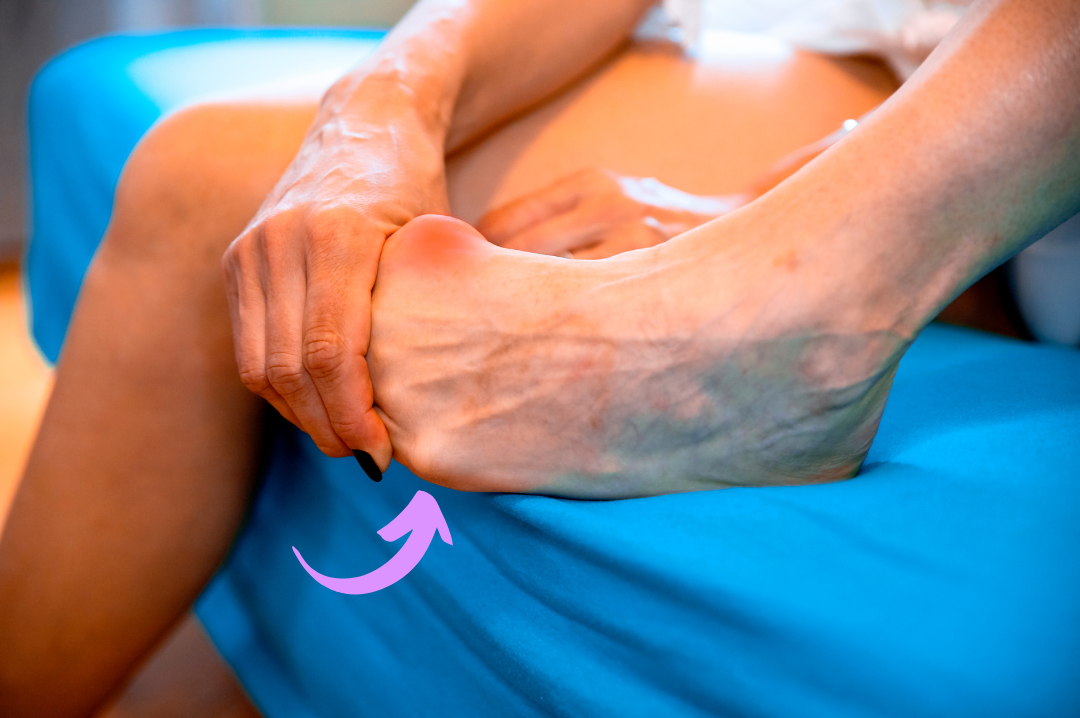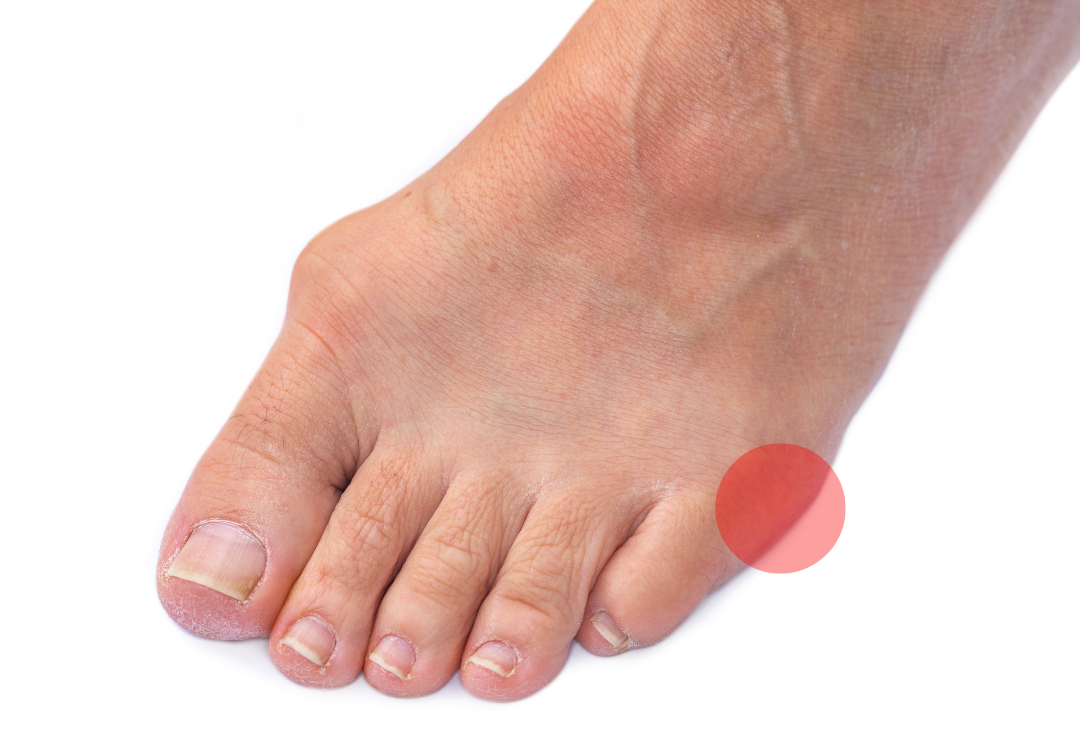
Jump to section
While regular bunions on the big toe are a common concern
for many, it is also possible to develop smaller, yet just as potentially problematic, bunions on the outside of the little (fifth) toes
called tailor’s bunions or bunionettes.
A tailor’s bunion is a small, bony protrusion on the outside edge of the ball of the foot - the opposite side as a regular bunion. Much like a regular bunion, the fifth toe may shift angles to face in towards the other toes. The name tailor’s bunion was coined because historically, tailors would sit cross-legged on the floor when working, which would constantly press and rub the outsides of their feet against their shoes and the ground, leading to the development of these bumps.
Alongside the bony protrusion on the outside of the foot, those with tailor’s bunions may experience:
As tailor’s bunions can progressively worsen over time if the right care isn’t taken, you may notice your symptoms growing more pronounced over time, with even greater structural and alignment changes at your forefoot. As such, it’s important to manage bunions early, where possible, to help prevent them from worsening or at least slow the rate of their progression so you can maintain your comfort and quality of life.
Tailor’s bunions are often the result of weakness, problems or issues with your foot biomechanics or the mechanical structure of your feet, which then leads to instability of the joints or overloading on the outside of your foot. On top of this, tailor’s bunions are further aggravated by:
In many cases, weakness and instability of the feet is linked to inherited (genetic) factors.
As the bony protrusion at the fifth metatarsophalangeal joint is quite pronounced, your podiatrist can confidently diagnose your tailor’s bunion based on a visual examination of the foot, any symptoms (like redness of the outside of the joint) as well as learning about your lifestyle factors (such as the tendency to sit cross-legged).
If we want to know more specific information about whether any damage has occurred within the joint, we can also refer you for x-ray imaging.
 Treating
a tailor’s bunion is done according to the level of flexibility available at the joint. For some, their tailor’s bunion will
be rigid and fixed in place, in which case the goal of the treatment is to help offload pressure away from the joint, treat any symptoms
like corns that have developed on the side of the bunion, help prevent it from worsening, and keep you as comfortable as possible while
you walk.
Treating
a tailor’s bunion is done according to the level of flexibility available at the joint. For some, their tailor’s bunion will
be rigid and fixed in place, in which case the goal of the treatment is to help offload pressure away from the joint, treat any symptoms
like corns that have developed on the side of the bunion, help prevent it from worsening, and keep you as comfortable as possible while
you walk.
For bunions that are still flexible and in their early stages, it may be possible to try to support a better joint alignment while also preventing the tailor’s bunion from worsening, or at least slowing it’s progress. In this case, we may use:
We also remove any corns or callus that has built up around the bunion, helping reduce pain and pressure on the joint.
Generally, we consider surgery for bunions as a “last resort” as the alternative non-surgical conservative options that we mentioned have proven to be successful in most cases. Surgery is an invasive procedure that carries risk, has a significant recovery time (8 weeks to 6 months), has no guaranteed results, instead putting you at risk of potential complications including nerve damage, infection, issues with bone healing, loss of movement in the little toe, pain, stiffness and more.
As such, we highly recommend trying non-surgical therapies first. If your symptoms do not improve and your tailor’s bunion is impacting your quality of life and day-to-day comfort, we can refer you for a consultation with a trusted orthopaedic surgeon.
Having your tailor’s bunion treated with our podiatry team at our Brisbane City and Newmarket clinics includes coming in for a consultation and assessment. and then having We’ll present and explain the treatment options that are suitable for you given your circumstances and the stage of your bunion,, as well as the outcomes we’d expect. After you select your preferred treatment path, we’ll get started on each of the therapies, doing what we can on the day and booking subsequent appointments as needed.
No, treating a tailor’s bunion is typically non-painful as it’s completely non-invasive and any hands-on manual therapies are gentle in nature.
The best way you can try to prevent tailor’s bunions is by wearing supportive, roomy shoes that have sufficient space in the toe box, while avoiding shoes that are narrow, pointed, cause rubbing along the sides of your feet, or are high-heeled. Pay close attention to any redness or rubbing on the outside border of your feet, and if you notice this, seeing your podiatrist immediately can also help any undue pressure from turning into a bunion.
Leaving a tailor's bunion untreated, especially if it’s causing you discomfort, may result in:
Orthotics are one treatment option that may be recommended for some people with a tailor’s bunion, if in their circumstances, their foot biomechanics is causing them to overload the little toe and outer border of the foot, leading to the joint destabilising and the bunion growing more pronounced over time.
No, a tailor’s bunion does not go away on its own, because the factors that have led to the bunion developing in the first place are usually not changed. It’s only when the causes of a tailor’s bunion are identified and addressed can positive change occur.
| Monday | 7:40am - 6:00pm |
| Tuesday | 7:40am - 6:00pm |
| Wednesday | 7:40am - 6:00pm |
| Thursday |
7:40am - 6:00pm |
| Friday | TEMP CLOSED |
| Saturday | CLOSED |
| Sunday | CLOSED |
Ground Floor, 344 Queen Street,
Brisbane City QLD 4000
| Monday | 7:40am - 6:00pm |
| Tuesday | 7:40am - 6:00pm |
| Wednesday | 7:40am - 6:00pm |
| Thursday |
7:40am - 6:30pm |
| Friday | 7:40am - 5:00pm |
| Saturday | 7:40am - 4:30pm |
| Sunday | CLOSED |
Newmarket Village, 114/400 Newmarket Rd, Newmarket QLD 4051